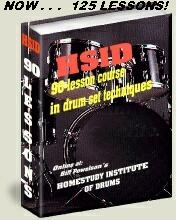HOLDING THE STICKS,
ATTACKING THE PEDALS,
AND
TIPS FOR LEFTIES.
It seems that every book and instruction method will cover these topics very well. I tend to automatically assume that students will get this info just about anywhere they may look. I really may be wrong to think that way.
Stick holding techniques occasionally cause considerable debate amongst students and educators alike . . . I like to avoid debates.
Keep your mind open on all this. My own opinions are just that. Opinions! I don't wish to argue or debate with the World. This is just my own personal viewpoint.
Some of us tend to view the forest from above while others prefer to examine the bio-structure of every blade of grass in the forest. "To each his own".
MATCH GRIP:
The 'Match Grip' is currently considered the best and easiest way to grip the sticks if you are behind a standard drumset. Simply imagine the drum stick as a hammer and you want to drive a nail with it. Hold both the right and left hand sticks the same way . . . so that they 'match'. (That's why we call it a 'match' grip.)
With the match grip, we occasionally use the fingers to manipulate the sticks. It all depends on the type of maneuver being employed.
On other occasions, all but the thumb and first (index) fingers may be removed to achieve a 'crush' or 'press' effect. This is done by griping the stick tightly between the thumb and first finger (only) then striking the drum, producing multiple notes with one movement of the hand. When this is done with both hands in rapid repetition, a 'buzz' or 'crush' roll can be achieved. As speed develops, this will equate to 'crushing' doubles, though the actual movement is a SINGLE (crushing) stroke with each hand.
The angle of the palms is arbitrary, depending on the maneuver being employed. As you traverse the drum kit, palm angle will vary considerably. It will come natural! Don't worry about all that . . . just play . . . and play a lot! The more you play the more your own natural coordinating abilities will kick in . . . you won't need to even think about it. The human mind will find the easiest and best way for you as an individual to make the moves. The secret is in playing, and playing a lot. Get into playing with recorded music and focus on that FUN factor! Play for hours on end! The muscle development will occur with very little attention to detail.
Different drummers throughout pop music history have developed their own unique methods of holding the sticks. It didn't inhibit their success as drummers. In fact . . . in some cases . . . their un-orthodox gripping techniques may have contributed to their personal fame and fortune. Keith Moon, who is accepted as one of the top 10 'all time' rock drummers makes a terrific example of this point. I could never feel comfortable with his personal method of holding the sticks but it didn't seem to hold him back. He tended to hold both sticks at the very end (or butt) of the stick. He simply pinched the very end of the sticks with the thumb and index finger. I don't know how he was able to play anything that way but it worked for him.
In essence . . . it doesn't matter how you hold the sticks. What matters most is what you can do at the kit.
TRADITIONAL GRIP:
Nearly every book on the market will show this method of gripping the sticks.
The right hand stick is held 'like a hammer' as with the 'Match Grip' . . . but the left hand is different when using the 'Traditional Grip'. Think of the left hand drumstick as a pen or pencil . . . except . . . you will place two fingers on top of the stick shaft and two fingers below the stick shaft. The butt of the stick will lay into the crotch or fleshy area between the thumb and first finger.
HISTORY OF THE TRADITIONAL GRIP:
The traditional grip originated with marching drummers who were playing a snare drum slung over the shoulder on a strap. The angle of the drum required the drummer to reach around the drum with the left hand and grip the stick differently. The 'Traditional Grip' was born at that time. The 'Match Grip' wasn't feasible in this very awkward and different marching situation. The Traditional Grip originated sometime during the 1500/1600s.
Drum sets were not created or invented until about 1840. The first drum set drummers were of course, marching drummers initially. So, as they sat down to play their new drum kits, they assumed the traditional grip as if they were playing a marching snare. As they taught others to play . . . the old traditional grip continued to be the grip of choice and eventually became 'set in stone' as the ONLY way to hold the sticks. WRONG!!! They weren't using much logic!
It took 120 years for our brilliant educators to accept any other method of holding the sticks. The traditional grip was set in stone and it wasn't to be discussed, haha. This doesn't say much for the general logic or common sense of our educators!
Sometime between 1955 and 1965 . . . the lights went on! In the mid-1960s Ringo Starr (with the Beatles) made several million dollars while holding a match grip. The stuffy old drum teachers were forced to ponder the issue a little deeper (myself included . . . blush, blush.) It took a few years of debate but I think in the final analysis all but a few die-hard old fogies have finally accepted the 'Match Grip' over the 'Traditional Grip'.
The traditional grip has its merit too. It doesn't hurt a thing to utilize both methods. I do that myself. At the same time, I tell all my young students to put the traditional grip aside for a rainy day . . . and get on with the job at hand. Make some music first and worry about the small stuff later!
SOUTH-PAWS: (Left handed students)
Many left handed students want to reverse the traditional grip along with everything else. That's ok if it works for you but this drum instructor recommends against it. Just use the match grip and move on. Hold both sticks the same way.
While we are on this (South-Paw) subject though, it may be good to touch on another issue of importance to left-handed students . . .
Left-handers who re-arrange the hi-hat to the right side of the kit need to experiment with a more acceptable way. Re-arranging the kit can be hazardous to your career for less than obvious reasons . . .
It often occurs that we must jump onstage and audition for potential jobs, using someone elses kit. A right-handed drummer will not appreciate it if you re-arrange his drums. Many will often say 'NO' to this very inconsiderate action. Also, changing drums around takes time and usually we are under pressure to simply get on stage and begin playing immediately! There may be no time to make the changes. You may wind up in the uncomfortable position of auditioning and playing on a backwards rig at the same time. Not cool!
WHAT'S A SOUTH-PAW TO DO?
Many of todays left-handed drummers have discovered a better way to be left handed. They set up their kit in the normal right-handed fashion and simply play the hi-hat with their left hand and their snare with the right. This is opposite from a right-handers technique.
They play the bass with their right foot and work the hi-hat pedal with their left just like a right-handed drummer though. This unique way of playing will mesmerize any and all right- handed drummers. The left-hander using this style will often rise to the top quickly because it is so logical, practical and unique.
Carter Beauford with the Dave Matthews Band is a prime example of a very hot drummer using this technique. I think Carter was voted drummer of the year in 1997 by Modern drummer magazine. Check him out . . . especially if you are a south-paw. His current glory doesn't seem to be a result of special talent. It seems that his rise to fame may be a direct result of this unique left-handed style.
ATTACKING THE PEDALS
Toe-Kick VS Heel-down
A debate has raged for decades concerning the BEST way to attack the bass drum and hi-hat pedals. Common sense should prevail here. This is my opinion . . . you are entitled to your own.
TOE KICK:
We scoot in closer to the pedals so that the shin is at a 90* angle to the floor. The heel is raised and the ball of the foot (only) connects with the pedal. This method of attack uses the full weight of the leg which allows for more power and speed. The (stronger) thigh muscles are also used extensively.
I advocate this method of attack even though I originally learned using the 'Heel Down' method. (See below.)
Yes! I feel this 'Toe-kick' is the very best way to play. I have no doubt on this one. However, it is still only an opinion.
HEEL DOWN:
All the older 'jazz' players were big on this method of attack. I am still more comfortable with this method myself even though I wish I had been taught the toe-kick from the beginning.
With the heel-down method . . . we scoot back a little, keeping the shin at an angle (approximately 75*) and the foot remains flat on the pedal. This uses the calf muscles. Some speed and power may be lost by using this method. Try both methods, you will feel the difference!
However, many of the worlds greatest jazz players have used this method of attack for years. You would never think they are operating at a handicap by using the 'heel down' method! However, common sense does dictate otherwise.
Again . . . as a final thought . . . it is best to use the methods that work best for you.
BEGINNERS: Take the. . .DRUMMERS APTITUDE TEST,now!
- INTERMEDIATE AND ADVANCED STUDENTS: Go to the following page for suggested lessons: KNOWLEDGE ASSESSMENT.
- Or, make your own determinations back at the Lesson Menu web page.
FOOD FOR FUTURE THOUGHT . . .
CLICK HERE: Read, Think and Decide.
****************************
Finite To Infinity
3 very important questions
IS IT POSSIBLE THAT YOUR 'NATURAL GIFT' OF RHYTHM CAN BE DOUBLED WITH ONLY A LITTLE ADDITIONAL (PREVIOUSLY UNAVAILABLE), KNOWLEDGE?
IS THERE A 'KNOWLEDGE GAP' IN YOUR OWN UNDERSTANDING OF 'RHYTHM'?
IS IT POSSIBLE TO GAIN A COMPLETE AND THOROUGH UNDERSTANDING OF 'ALL RHYTHM', WITHIN ONLY A COUPLE HOURS OF EASY, AND FASCINATING, STUDY ?
Answers: YES! YES! YES!
Get All Products Here

GET ALL THE PRODUCTS AT ONE LOW PRICE.
SURPRISES ABOUND!!!! . . . For those with a bit of generosity in their soul.
CLICK HERE , to see what I mean.
Intermediate & Advanced Drummers
- Drum Instructors Wanted
- Teach My Lessons and Methods
- Up to $60.00/hour
Pre-School Drummer?
Can we teach rhythm to pre-schoolers? YES!
This is a very short course, designed to help adults plant the seeds of rhythm into children of nearly any age. Click Here!!
Make CASH $$$ Now!!!

FREE ELECTRONIC BOOK BONUS (also included) BUSINESS OPPORTUNITY:
- * MAKE BIG MONEY SELLING USED DRUMSETS!
- * INSIDER HARDBALL-BUYING-TIPS AND SECRETS.
- * UNIQUE RECOVERING SECRETS
Support Us Today!!
Support this site and and gain an advetising bargain with the deal. Place a permanent ad here.
